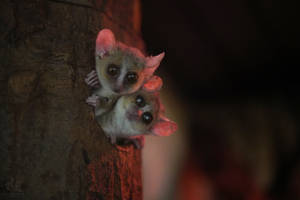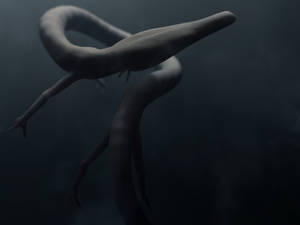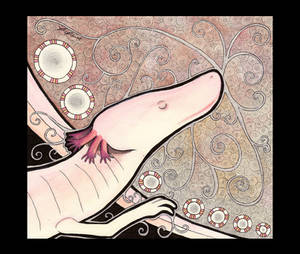From the first moment I've laid eyes on these two amphibians, they struck a chord and I've been fascinated. They may seem somewhat similar in appearance, yet are unrelated and in fact, natively occur on two different continents. The Olm calls Middle Europe home, while the Axolotl is based in South America.
Generally white to pinkish in colour, they are also known in dark to almost back mutations. Both have gills, that form a crown around their necks. No matter their similarities and differences, they have both adapted to very different circumstances and have therefore adapted their peculiarities for entirely different reasons. In this week's Animals Anonymous, we hope to enlighten you on Axolotls and Olms.
The Olm is a Salamander which can only be found in caves - not in the crevices, nooks and crannies, but in the waterholes. It will spend its whole life in that water. Because of it's colouring, it's known by the denominator of "human fish", as the most common Olm has a skin colour similar to the people living in the nearby area of the Dinaric Mountains. As the olm spends all of its life in the dark and water, their eyes are underdeveloped, leaving them blind. On the other hand, their other senses are developed to a higher level, those of smelling and hearing. Due to these living conditions, their limbs are underdeveloped, leaving them with few toes and fingers on their feet. The trait they share with the Axolotl is that even after reaching adulthood they still sport external gills, which are usually only present in juvenile salamanders.
The full size of the Olm ranges between 20 to 30 centimeter (8-12 inches), though some have been observed to almost double this size to a length of 40 centimeter. Their head is long and thick with a stumped snout. They are predators, mainly relying on small crabs, snails and insects which share its habitat. They have been found to go without eating for as many as ten years and still live.
Considering they live in a rather limited environment (the Dinaric Mountain caves and underwater systems), their habitat is very fragile. Any kind of disturbances and development of the caves can have far-reaching effects on their foodsources, habitat and where they raise their young. Pollution of the water around the caves has effect on the water quality underground, where the Olm relies on. As many pollutants introduced into these systems are not degradable by nature, they too, can have far-reaching effects on the Olm. Their conservation status is now listes as vulnerable due to this cumulation of factors on their habitat.
The black permutation of the Olm has been recognized as a separate subspecies, distinguished not only by their colour, but their body size differs as well. They have a different number of vertebrae, their limbs are shorter in comparison to the white Olm, and their eyes are better developed. Where they natively occur in Eastern Europe, they have been introduced in a cave in Germany, where they have lived since the 1930s with some success. In total, 18 of them were introduced in this cave, where they have first reproduced succesfully in 2016. A similar project takes place in France, where in 1952 a project was started to observe the Olm, where over the past 60 years, the population has grown to a total of 400. In captivity, Olms have been found to reach an age of 70, though scientists presume they can top this and even reach an age of 100. Scientists deem that this surprising life span is due mostly to the lack of predators in their cave system; when these are absent, there is no reason for them to die early.
The Axolotl is home to a water system in Mexico, where it is vulnerable to some of the same threats as the Olm in Europe. They measure from 15 to 45 centimeters in length (6-18 inches), though on average they measure around 23 centimeters, making them similar in length, though different in build from the Olm, apart from their feathery gills. They have more sturdy legs which they use more, with a prounounced tail and hindpart, where the olm is more eel-like in body. In the wild they were more commonly black or dark skinned, where in captivity white Axolotl are very common. Despite being known for their juvenile looks even in adulthood, Axolotls have been known to lose those appearance and become full-fledged Salamanders.
Originally, they have been native to two lake systems in Mexico - Lake Xochimilco and Lake Chalco - though this day, the latter no longer exists, as it was drained due to the periodic flooding it caused. The former has also been reduced in size and wildness and exists mainly as a series of canals in present day, putting a large stressor on the Axolotl.
The Axolotl is currently classified as critically endangered. In a survey from 2013, no live Axolotl were detected, which bodes very ill for their future in the wild. Not only has their habitat drastically decreased, in this habitat they also face unnatural threats in the shape of introduced animals, they have been subject to the pet-trade and they used to be considered a delicatesse to eat.
While suffering from predation, the Axolotl itself is a predator as well. Though when compared in looks to the Olm, the Axolotl's eyes are far more visible and obvious, they too suffer from poor eyesight and will mostly find their food, which consists of small fish, insects and worms, through smell.
Another interesting trait showcased by the Axolotl, is their ability to regenerate. When they lose body parts, they can regrow them, which isn't unheard of in the animal kingdom, but where the Axolotl is truly unusual is in its ability to regrow internal organs, their bones and even their brain. This mostly counts for the ever-young Axolotl. Those Axolotl which have broken their usual habit of retaining forever youth, will showcase a decreased ability to regrow lost body parts.
ShopDreamUp AI ArtDreamUp

Tip Jar
If you love our (zoo) photography, it would mean the world if you could support us.
This subscription does not contain any perks or added content, but it allows us to continue visiting zoos (travel and entrance fee) and keeping our camera gear up and running.
And of course, you'll have our neverending gratitude and appreciation.
$1/month
Say Bye-Bye 2023
At the end of each year, we take the time to reflect on that year and all that we saw and everything that happened. As I'm writing this, I can't help but think that over the past few years the world has become a lot scarier. I'm sure it's a matter of European white privilege, that one can know there's famine, war and genocide happening in the world but as long as it's outside of the "western world"? It barely makes the news, perhaps a byline every now and then. But once it gets too close, it becomes everyday news and you're actually facing it in the streets. Our hearts go out to everyone fleeing their homes and running for their lives - leaving behind everything and everyone they know. Civilian casualties are unacceptable collateral, but in the face of religious and political disputes it's always innocent bystanders - just trying to live through the day to see another tomorrow - who end up hurt. In the Netherlands too, we're facing a change due to the outcome of the November
UPDATE 2: Can you help us help? - Cat Cafe in need
Hi everyone :wave: It's been a while since I've given you all an update on beautiful young cat Harry who's been suffering from an undiagnosed, serious disease. You can read up on the situation here: It is so difficult to express into words how much it means that you've helped us support our favorite cat café and sweet Harry. It means the world:hug: Thanks to your dear support, we've been able to make a donation of a nice sum of money to help towards his vet costs :heart: As for his current situation, I wish I had good news to share. Mid-November, his blood was examined again. He was doing slightly better than before, but we all knew he wasn't out of the woods yet. They continued his meds, so he could have his blood examined again, today. Sadly, last week Harry wasn't eating and they had to rush him to the vet. He got a dosis of Prednison and it's helped slightly. It looks as if the medication do work for a few days, but then the effects water down until they don't do
UPDATE 1: Can you help us help? - Cat Cafe in need
Hi everyone :wave: These last few months have been crazy for our favorite cat cafés... So many cats in all different cat cafés have fallen seriously ill and passed away. We asked your help mid-August in this journal for a specific, very unlucky cat café: Familie Snorhaar in Breda, the Netherlands is one of our favorite cat cafés. We try to visit every few months, and the owner knows us by face - and actually, so do some of the cats! Although they might recognize the tread of our feet and the smell of our bags more than they recognize our faces. In the above journal, we shared with you all the unlucky events leading to sky-high vet bills. We want to share with you an update on the current situation. Luna is home! She was missing for nearly a whole month - having walked into a humane trap and returned to the cat café on August 23. Her fur is a bit worse for wear, she's lost weight and you can tell by looking at her she's had to survive in tough conditions. Harry has been doing
Can you help us help? - Cat Cafe in need
Hi everyone :wave: If you know us a little, you hopefully know nwe love cats. Aside from our zoo photography hobby (where we're known as Mouselemur or Mouselemur Photography), we also actually visit cat cafés and photograph the cats there (where we go by Zusjes Portegies). We have a voluntary collaboration with some, who use our photos in their menus, their little books that tell you about the cats and the cat café, and use our photos on their website and social media :D Our absolute favorite cat cafés (Familie Snorhaar) is going through a really hard time. One of their youngest residents named Harry suddenly fell critically ill. While investigating a possible diagnosis - a highly contagious one - the other cats had to be tested as well. While outside and in her carrier, one of the cats named Luna escaped out of her carrier! She's been missing since. Later that week, they had to say goodbye to one of their cats named Stella because of untreatable cancer. Meanwhile, it's
Featured in Groups
Comments16
Join the community to add your comment. Already a deviant? Log In
Such magnificent creatures!  The Axolotl in particular is adorable. <: I learned a lot about both from this feature, thank you!
The Axolotl in particular is adorable. <: I learned a lot about both from this feature, thank you!



























